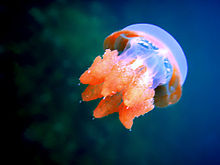Kakaban island is part of the Derawan Islands, East Kalimantan, Indonesia.
The island has an area of 774.2 hectares (1,913 acres) and is quite steep. Its limestone cliffs are covered with dense jungle right down to the water's edge. The wall drops to 180 metres (590 ft), and currents can be strong with upwelling, downcurrent and reversing directions.
The most distinctive feature is the huge brackish water lake in the middle of the island, in the local dialect Kakaban means "hug" as the island hugs the lake from the surrounding seawater.
Jellyfish Lake

In the middle of this island is a mangrove-fringed lake, slightly above sea level, where thousands of jellyfish live, making it interesting for diving. The jellyfish consist of four different species which do not have the ability to harm humans with their stinging cells. They are Aurelia aurita with a transparent body, Tripedalia cystophora which is fingertip size, Mastigias papua is like a green-brown bulb, and Cassiopea ornata which is an upside-down jellyfish with upright tentacles. Although they cannot sting humans, they still have poison and can sting their prey. Similar lakes exist in the Philippines (Siargao), and in Palau, with Jellyfish Lake being the best known.
The lake has warm brackish water and the bottom is covered with marine green algae. There are other animals, including sea cucumbers, gobies, sea anemones, tunicates, crustaceans, nudibranchs, orange purple clams and yellow clams on the branches, and snakes.
The lake is at most 17 metres (56 ft) deep with poor visibility and is 10 minutes walk from the beach. Kakaban was probably uplifted during the Holocene era and seawater was trapped, forming a landlocked marine lake. The water is now a mixture of saltwater and fresh water from rain.
Barracuda Point
This is a steep wall, where the current brings large pelagics like whitetip sharks, leopard sharks, jack, tuna, snapper and barracuda. Drift diving can be done with the help of a grab line permanently secured 24 metres (79 ft) across a relatively flat area on the upcurrent side of the point. Currents can be fierce with down currents.
Blue Light Cave
The cave starts at a crack at 2 metres (6 ft 7 in) deep and descends through a narrow chimney. At about 21 metres (69 ft) the chimney opens into a large cavern that extends for about 120 metres (390 ft). The exit is a long vertical crack in the wall at 44 metres (144 ft). The name of the cave comes from the blue light of the sea which is seen from the cavern.
References
- Govt promotes new diving paradise in Aceh and Kalimantan
- "Danau Kakaban Danau Air Asin Paling Unik di Dunia". April 21, 2013.
| Regencies and cities of East Kalimantan | ||||
|---|---|---|---|---|
| Capital: Samarinda | ||||
| Regencies |
| |||
| Cities | ||||
2°08′57″N 118°31′48″E / 2.1491°N 118.5299°E / 2.1491; 118.5299
Categories: